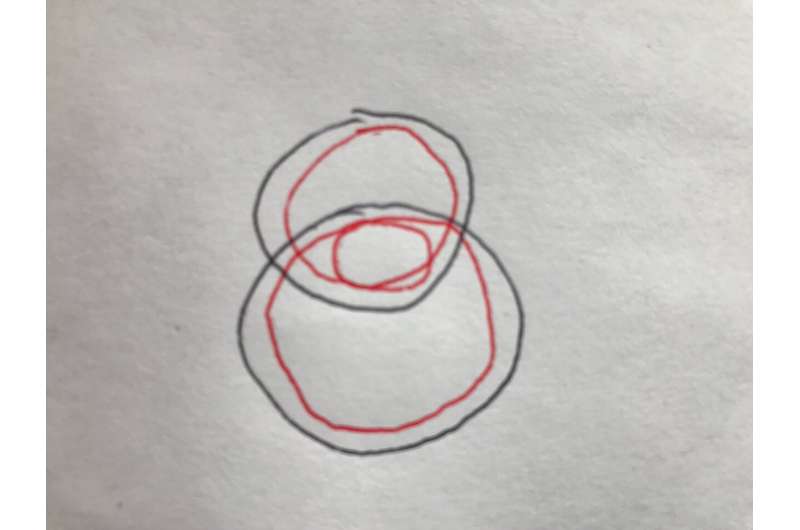The initial sketch outlining the idea behind the study, made by Erik Schnetter.
Researchers at the Max Planck Institute for Gravitational Physics, Rochester Institute of Technology and the Perimeter Institute for Theoretical Physics have recently gathered strong numerical evidence for a new phenomenon that takes place in the interior of binary black holes. In their study, published in Physical Review Letters, they collected observations that could offer exciting new insight into the merger of marginally outer trapped surfaces (MOTSs) in a binary black hole (BBH), a system consisting of two black holes in close orbit around each other.
"It is an underappreciated fact that event horizons are not really very useful for studying astrophysical properties of black hole mergers," the researchers told Phys.org via email. "What is much more useful are surfaces which go under the boring name of marginally outer trapped surfaces (marginal surfaces or MOTS in short). This uninteresting name hides their importance in understanding black holes."
Over the past 15 to 20 years, two of the authors of the recent paper, Badri Krishnan and Erik Schnetter, have developed ways of using marginal surfaces to calculate, among other things, black hole mass and angular momentum. Despite their achievements in this area, they were unable to answer a key question: do MOTSs merge in a BBH coalescence, and if so, how, exactly?
The researchers were keen to find out more about this merger, as well as to unveil any interesting topological features that may be hidden within it. Daniel Pook-Kolb, another author of the paper and a Ph.D. student at the Max Planck Institute, thus decided to investigate this topic further in his thesis.
"To understand the merger, we need to locate very highly distorted marginal surfaces, a numerically challenging task that defeated all previous studies," the researchers said. "We developed a new numerical technique for this task and got ever closer to the merger point. Still, even our methods do not work extremely close to the merger, where surfaces with cusps appear."
As the researchers were unable to gain the insight they were looking for in their previous studies, they continued looking for different routes to investigate the merger of MOTSs in a BBH system. Eventually, Schnetter came up with a new idea for approaching this topic, which entailed looking for surfaces with intersecting loops.
Credit: Pook-Kolb et al.
When he proposed this to the rest of the team, Krishnan was somewhat skeptical, as no previous literature had explored this idea before, but Pook-Kolb decided to investigate it regardless and look for such surfaces. Eventually it turned out that such topological features do exist, and that they could, in fact, be generic features of black hole mergers.
Essentially, the researchers simulated the head-on collision of two non-spinning black holes with unequal masses. In these simulations, they observed that the MOTS associated with the final black hole resulting from a BBH merger unites with the two initially disjoint surfaces that correspond to the two initial black holes in the system.
This results in a connected sequence of MOTSs interpolating between the initial and final state of the BBH, up until the merger between the two black holes eventually takes place. Ultimately, their findings highlight a topology change in the merge of marginal surfaces.
The observations gathered in their simulations also hint to the existence of a MOTS with self-intersections that is formed immediately after the merger. The researchers, however, expect that another one of their findings will have far greater implications for future gravitational wave observations.
"Since we now have a sequence of marginal surfaces taking us from the two initially disjoint black holes to the final one, we can calculate in detail how physical quantities of black holes behave during the merger," the researchers said. "It would be especially interesting to find similar features in the observed gravitational wave signals: We can then rightfully claim to observationally understand what happens inside a black hole event horizon."
The numerical evidence gathered by Pook-Kolb, Schnetter, Krishnan and their colleague Ofek Birnholtz offers fascinating new insights about BBH mergers. In the future, their observations could pave the way for new studies, including attempts to prove mathematically the Penrose inequality for generic astrophysical BBH configurations.
The researchers are now planning to try generalizing their idea to other black hole mergers, such as those observed by the LIGO collaboration. This could make the theory they came up with usable by a much larger research community.
"Work on generalizing our idea to generic mergers is underway, and the first results building on the same theory are now coming up," the researchers said. "We are extremely excited to see what awaits us in simulations of fully general realistic mergers!"
More information: Daniel Pook-Kolb et al. Interior of a Binary Black Hole Merger, Physical Review Letters (2019). DOI: 10.1103/PhysRevLett.123.171102
Journal information: Physical Review Letters
© 2019 Science X Network
























